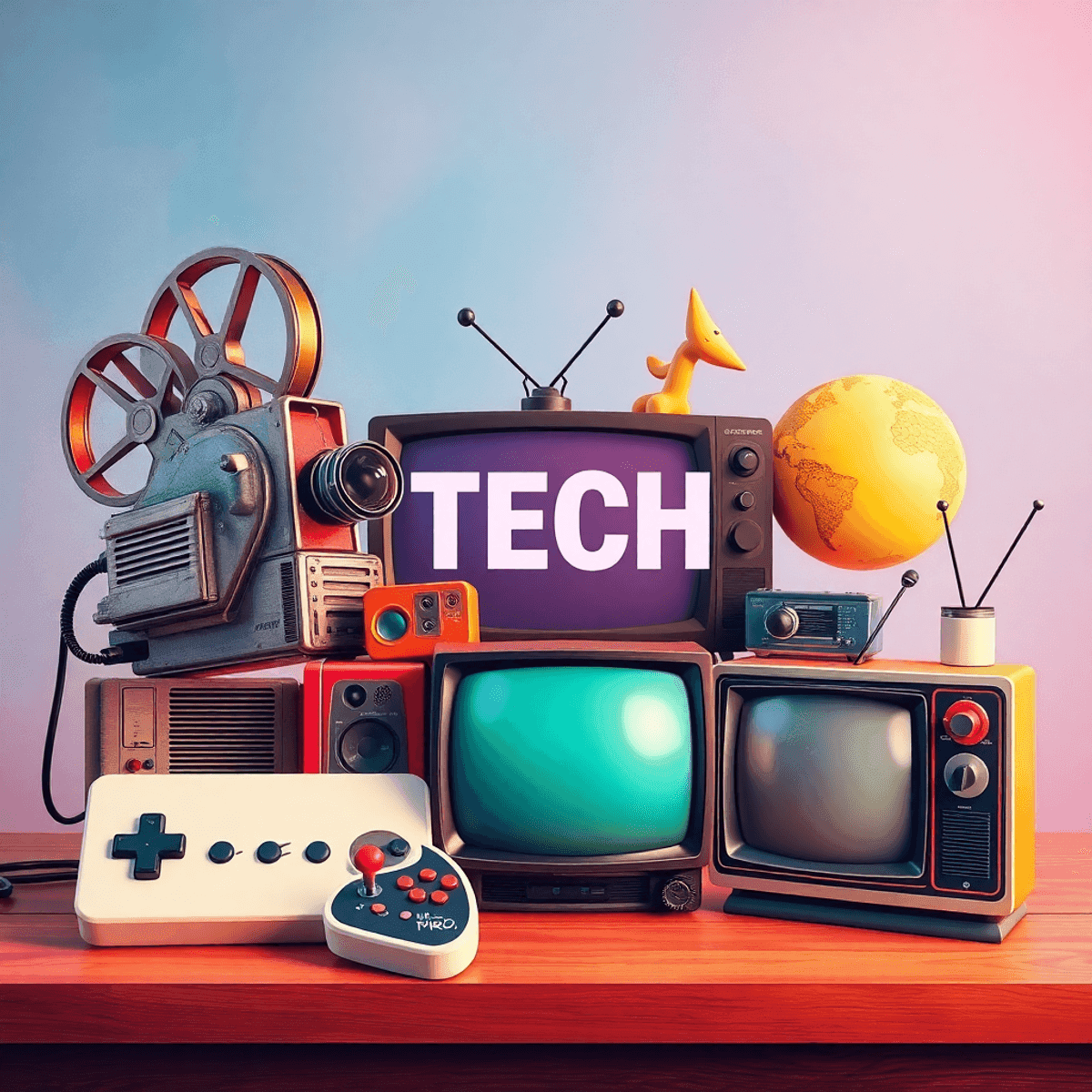Introduction
Tech entertainment is an exciting blend of new ideas and cherished memories, showcasing how technology has evolved across different types of media.
- Nostalgia is a key factor in shaping our preferences, leading us back to the experiences that once captivated us.
- By understanding this connection, we can see how technological advancements have not only changed entertainment but also brought back fond memories of the past.
By examining the growth of technology in movies, video games, and online media, we can gain a better understanding of how these industries have evolved. Each major advancement has brought about new experiences while still honoring our shared history. This nostalgic look back at the greatest forms of tech entertainment allows us to appreciate both the progress made and the moments that remind us why we fell in love with these art forms in the first place.
The Evolution of Cinema
The journey of cinema began with the invention of moving pictures in the late 19th century. In 1891, the Edison Company created the Kinetoscope, a device that allowed individuals to view short films through a peephole. This marked the beginning of film exhibitions, captivating audiences in arcades and fairgrounds. The first public demonstration by the Lumière brothers in 1895 showcased short films that depicted everyday life, igniting a passion for storytelling through visual media.
Key Milestones in Cinema Technology
As cinema history unfolded, significant technological advancements shaped its trajectory:
- Introduction of Sound: The transition from silent films to “talkies” occurred in 1927 with Warner Brothers’ Vitaphone system, synchronizing sound with visuals. This milestone transformed audience engagement, allowing narratives to deepen through dialogue and music.
- Color Films: The emergence of color film in the 1930s, particularly with Technicolor processes, introduced vibrancy to storytelling. Iconic films like The Wizard of Oz (1939) showcased this innovation, forever changing visual aesthetics in cinema.
The Golden Age of Hollywood emerged during the early 1930s, establishing a framework for modern filmmaking. Studios produced feature-length movies with synchronized sound and color, creating a new standard for cinematic experiences. Stars like Clark Gable and Katharine Hepburn became household names, while genres solidified their place in pop culture. Audiences flocked to theaters for grand narratives and larger-than-life performances.
Despite its growth, cinema faced challenges when television became widely accessible post-1940s. Attendance at theaters declined as families opted for home viewing experiences. However, this decline prompted innovations that would reignite interest in cinema.
Digital advancements revitalized the industry by enhancing both production and distribution methods. Filmmakers embraced digital technology for shooting and editing, leading to improved efficiency and creativity. The advent of digital cinema made high-quality filmmaking accessible to independent creators.
- IMAX Formats: Introduced in the late 1960s, IMAX took immersion to new heights. This format features larger screens and enhanced audio systems, creating an experience that envelops viewers entirely within the film’s world.
- Rise of 3D Movies: Technological developments also brought about 3D movies, which gained popularity with films like Avatar (2009). Utilizing stereoscopic imaging techniques, these films provide depth perception that draws audiences further into the narrative landscape.
In recent years, streaming platforms have revolutionized how audiences consume films. With convenience becoming paramount, viewers can access an extensive library of movies from home or on-the-go. Independent filmmakers now find opportunities to showcase their work without traditional studio backing.
The evolution of cinema reflects an ongoing dialogue between technology and artistic expression. As innovators continue to explore new frontiers within the medium—whether through IMAX’s immersive experiences or digital formats—cinema remains a powerful form of storytelling that resonates deeply with audiences across generations.
The Rise of Video Gaming
The journey of video gaming showcases a remarkable evolution from simple, pixelated experiences to a dynamic and complex industry that captivates millions.
Evolution of Video Games
1. Early Beginnings
The origins of video games trace back to the 1950s and 1960s with titles like Tennis for Two and Pong. These games were basic in design, utilizing simple graphics and straightforward mechanics.
2. Arcade Era
The 1970s and 1980s ushered in the golden age of arcade gaming. Games such as Space Invaders and Pac-Man became cultural phenomena, igniting a passion for gaming among players.
3. Home Consoles
The introduction of home consoles like the Atari 2600 transformed gaming into a household activity. Players could enjoy their favorite titles without needing to visit an arcade.
Appeal of Retro Gaming
Nostalgia plays a significant role in the continuing appeal of retro games. Many players find joy in revisiting classics due to:
- Simplicity: Early games often focused on gameplay mechanics rather than intricate graphics, creating accessible experiences that anyone could enjoy.
- Cultural Significance: Titles like Super Mario Bros. and The Legend of Zelda not only defined genres but also created lasting memories for those who experienced them during their formative years.
Social Interaction in Early Gaming
The early gaming landscape fostered unique social interactions among players:
- Shared Experiences: Many games required multiplayer participation, encouraging friends and family to gather around a single console.
- Community Building: Arcades became social hubs where players engaged with one another, sharing tips or competing for high scores.
Modern Gaming vs. Retro Gaming
The contrast between modern and retro gaming is striking:
- Graphics Evolution: Today’s games boast stunning visuals and lifelike environments, thanks to advancements in technology. Realistic graphics have transformed player immersion and narrative complexity.
- Game Design Complexity: Modern titles often feature extensive storylines, open-world exploration, and intricate gameplay mechanics. This complexity can sometimes overshadow the straightforward enjoyment found in retro games.
Revisiting Retro Games
Despite advances in technology, there remains value in revisiting retro games:
- Enjoyment Factor: Many players find that classic gameplay mechanics offer a refreshing break from modern complexity. Titles like Tetris or Donkey Kong remain enjoyable due to their straightforward objectives.
- Accessibility: Retro games often require less time commitment compared to modern AAA titles, making them ideal for casual play sessions.
Gameplay Mechanics Then and Now
A comparison of gameplay mechanics reveals how far the industry has come:
- Simplicity vs. Complexity: Early games relied on intuitive controls and clear objectives, while contemporary titles often feature multiple layers of strategy and skill development.
- Feedback Systems: Modern games provide immediate feedback through tutorials, achievements, and online leaderboards, enhancing player engagement.
The evolution of video gaming reflects cultural shifts and technological advancements that have redefined entertainment norms. The nostalgic allure of retro gaming continues to captivate audiences seeking connections to simpler times while modern innovations push the boundaries of what gaming can achieve.
The Internet’s Impact on Entertainment
The journey of the internet has profoundly reshaped how we consume media. From its early days as ARPANET to the digital platforms we use today, the evolution marks a significant turning point in entertainment history.
Internet History and ARPANET
1. Origins and Purpose
Initiated in the late 1960s, ARPANET was designed for robust communication among researchers and military installations. Its architecture emphasized resilience, which laid the groundwork for modern internet connections.
2. Development of Protocols
Key protocols like TCP/IP emerged, streamlining how data is transmitted across networks. This technological foundation facilitated seamless communication that became essential for online entertainment.
Emergence of Web Browsers
1. Introduction of Mosaic
In 1993, the Mosaic web browser revolutionized media access by providing a user-friendly interface. It made navigating websites easier, opening doors to a wealth of information and entertainment.
2. Impact on Media Consumption
With browsers allowing users to view multimedia content such as videos and images, traditional barriers to accessing information crumbled. This transformation marked the beginning of an era where entertainment could be consumed anytime, anywhere.
Transformation of Media Consumption
Today’s digital landscape is dominated by streaming services that redefine how audiences engage with content.
1. Rise of Streaming Services
Platforms such as Netflix, Hulu, and Amazon Prime Video have changed viewing habits.
- Subscription models provide unlimited access to vast libraries of films and series.
- Users can binge-watch entire seasons at their own pace, a stark contrast to traditional cable schedules.
2. Social Media Influence
Platforms like YouTube, TikTok, and Instagram have empowered individuals to create and share content.
- User-generated content has blurred the lines between consumers and creators.
- Engagement through likes, comments, and shares fosters community interactions around shared interests in entertainment.
In recent years, nostalgia has found its place within these digital platforms. Many streaming services feature classic shows and films that evoke fond memories for viewers. Remastered versions or reboots are common offerings that allow a new generation to experience beloved stories while also appealing to older fans craving familiar narratives.
Digital media consumption extends beyond passive viewing; it invites active participation. Fans engage with content through discussions on social media or by creating fan art based on their favorite characters. Communities form around shared interests, reinforcing connections between technology and entertainment.
The integration of technology into entertainment continues to evolve rapidly. Virtual reality (VR) experiences provide immersive storytelling opportunities that transport users into different worlds. Augmented reality (AR) games enhance real-life environments with digital elements, further merging tech with leisure activities.
Nostalgic recap moments often emerge from this blend of past influences with modern innovations. Classic video games are available on contemporary consoles or mobile devices. Remakes of iconic movies find new life in theaters while retaining core elements that resonate with long-time fans.
The internet not only serves as a conduit for consuming entertainment but also shapes cultural conversations around it. As technology progresses, so does our relationship with it—melding nostalgia with innovation in ways that continue to enrich our experiences in tech entertainment.
Nostalgic Connections in Tech Entertainment
Nostalgia plays a powerful role in shaping audience preferences within tech entertainment. The nostalgia effect evokes fond memories, influencing choices in films, games, and music. This emotional connection often drives audiences to seek experiences that remind them of their past.
The cultural significance of revisiting past forms of entertainment cannot be understated. It serves as a bridge between generations, allowing younger audiences to explore the roots of modern media while giving older generations a chance to relive cherished memories. Key reasons for this resurgence include:
- Remastered Versions: Classic games and films receive updates with enhanced graphics and audio, making them accessible to modern audiences while retaining their original charm.
- Reboots and Sequels: Franchises like Ghostbusters and Jurassic Park tap into nostalgia by reintroducing beloved characters and storylines, creating a sense of continuity that resonates with fans.
- Soundtrack Revival: Musical scores from iconic films often find their way back into contemporary productions, invoking nostalgia that enhances emotional engagement.
Examples abound in today’s entertainment landscape. The success of platforms like Disney+ highlights the demand for nostalgic content as viewers flock to classic shows and movies. Similarly, gaming companies frequently release compilations of retro titles, inviting new players to experience the simplicity and creativity that defined early gaming.
Nostalgia embodies more than just remembrance; it fosters deeper audience engagement through shared experiences rooted in cultural history. This phenomenon is not just limited to individual preferences but also plays a significant role in shaping our perceptions of popular culture as discussed in this insightful piece on the role of nostalgia in shaping perceptions of popular culture.
Conclusion
The journey through time in tech entertainment reveals a rich history filled with amazing progress and beloved memories. Each era introduces its own innovations that shape our experiences, reminding us of the magic that first captivated our hearts.
- Embracing both nostalgia and innovation allows you to appreciate the past while exploring future trends.
- The evolution continues, revealing new forms of storytelling and engagement that build on the foundations laid by earlier technologies.
As we look back on this nostalgic recap of the best forms of tech entertainment, let’s acknowledge the lasting impact these experiences have on our culture. The combination of retro charm with cutting-edge developments encourages us to explore new frontiers in entertainment, ensuring that both memory and progress coexist in this ever-changing landscape.
FAQs (Frequently Asked Questions)
What is tech entertainment and how does it relate to nostalgia?
Tech entertainment refers to various forms of media that utilize technology, such as films, video games, and digital content. It is closely linked to nostalgia as many individuals find comfort and joy in revisiting past technological advancements and entertainment experiences that shaped their childhoods.
How has cinema evolved over the years?
Cinema has undergone significant evolution since the inception of moving pictures. Key milestones include the introduction of sound and color, the Golden Age of Hollywood, and advancements in formats like IMAX and 3D movies. Digital technology has further revolutionized filmmaking and distribution, leading to a resurgence in cinema’s popularity despite challenges from television.
What are some nostalgic elements in modern video gaming?
Modern video gaming often incorporates nostalgic elements by revisiting retro games with remastered versions or reboots. The simplicity of early game design appeals to players, fostering a sense of nostalgia while also allowing for social interaction reminiscent of earlier gaming experiences.
How did the internet change media consumption habits?
The internet has dramatically transformed how we consume media through the advent of streaming services and online content creation. The development of ARPANET laid the groundwork for modern communication systems, while web browsers like Mosaic made accessing digital content easier than ever.
What role does nostalgia play in audience engagement with tech entertainment?
Nostalgia significantly shapes audience preferences by evoking emotional connections to past experiences. This cultural significance drives interest in revisiting classic films, games, and music, often reflected in modern tech entertainment through nostalgic themes or familiar formats.
What future trends can we expect in tech entertainment?
As technology continues to evolve, we can anticipate new innovations within tech entertainment that blend nostalgia with cutting-edge advancements. This ongoing journey will likely see a fusion of past influences with modern creativity, encouraging audiences to embrace both innovation and cherished memories.









